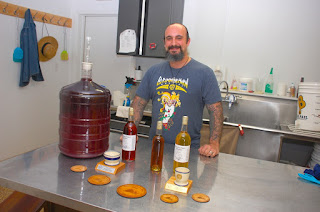Mead, follow, or get out of the way
 |
Seaford resident Jon Talkington, one of the owners of the planned
Brimming Horn Meadery in Lewes, has won some of the
most prestigious awards bestowed upon mead makers.
|
That one of the oldest drinks in history also is among the most obscure makes sense on some level. After all, mead hasn’t been a commonly served drink in America for at least a couple of hundred years. The fermented honey drink mostly is associated with Vikings and medieval castles, not as an alternative to beer or wine at a local bar or restaurant. Increasingly, though, people are open to new taste experiences and mead is having something of a renaissance among the more adventurous.
Jon Talkington, who has been making mead in his Seaford home for years, hopes to be on the front line of the next step in the reintroduction of this ancient drink — returning it to the main stream. He and his business partner, Robert Walker, have recently received approval to open Brimming Horn Meadery, in Lewes.
Once opened, people from all over the region who travel to the tourist destination will have the opportunity to try mead and, if they find it to their liking, to take it home or request it in their local restaurants. But creating that kind of demand is really phase II of the Brimming Horn project. Phase I requires spreading the word that mead is a thing, and that that thing is different from both beer and wine. Also, that mead is made at a meadery.
When Talkington describes his project to people, they tend to think he’s opening some kind of shop that does something with meat, and it’s hard to blame them. In getting licensed, the guys from Brimming Horn Meadery even confused the regulators.
For the Delaware license, the Brimming Horn Meadery will operate under the rules that allow breweries. For the federal license, the meadery will operate as if it is a winery.
Although people who are familiar with the culture might have access to some meads, for the most part, it is only newly in mass production.
Mead is made from honey, water and yeast (the yeast ferments the sugar into alcohol). When people started making it about 9,000 years ago, they probably did so by throwing an entire beehive into a pot to cook the honey out of it. Since yeast occurs naturally and pretty much everywhere, it is likely that the earliest meads were accidents that helped people discover yeast and what it was capable of doing.
“Mead is easy to make,” Talkington said. “Good mead is hard to make.”
Talkington has been making mead since he was a kid. One of his high school teachers helped him make a lemon mead called “sima” which is a Finnish celebratory drink with very little alcohol made for children.
Add to that the fact that both of his grandfathers were enthusiastic about homemade libations — one made wine and the other beer—and Talkington had a ready-made culture to embrace and become part of. In recent years, he has won prestigious mead-making awards all over the region and even nationally.
On the heels of his success with mead, Talkington became interested in brewing, eventually taking a job at the Dogfish Head Brewery in Milton where he worked his way up from cellarman to brewer.
During his time there, he developed his business savvy as well as his ability to deal with liquids on a large scale, and, as many of his contemporaries struck out on their own to open breweries, Talkington was drawn to the fermentable that got him started.
“Mead has always been a passion of mine,” he said, adding that it also was different enough that it would attract people, but not so different as to scare them off.
The Finnish sima isn’t radically different from, for example, the hard lemonades and twisted teas that are popular among those who prefer something sweeter than beer but not wine.
Talkington and Walker already are in talks with local fruit and honey producers from whom they hope to get the better part of their ingredients. Brimming Horn Meadery will sell more than just honey mead.
The owners expect to make a variety of meads by adding fruits and other natural ingredients to bring out or add character to their various meads.
Buying local whenever possible is more than about sustainability, it also is about economics. The expectation is that committing to local ingredients will produce a superior mead without driving the cost up too high.
This story originally appeared in the July 9 edition of the Seaford Star.

Comments
Post a Comment